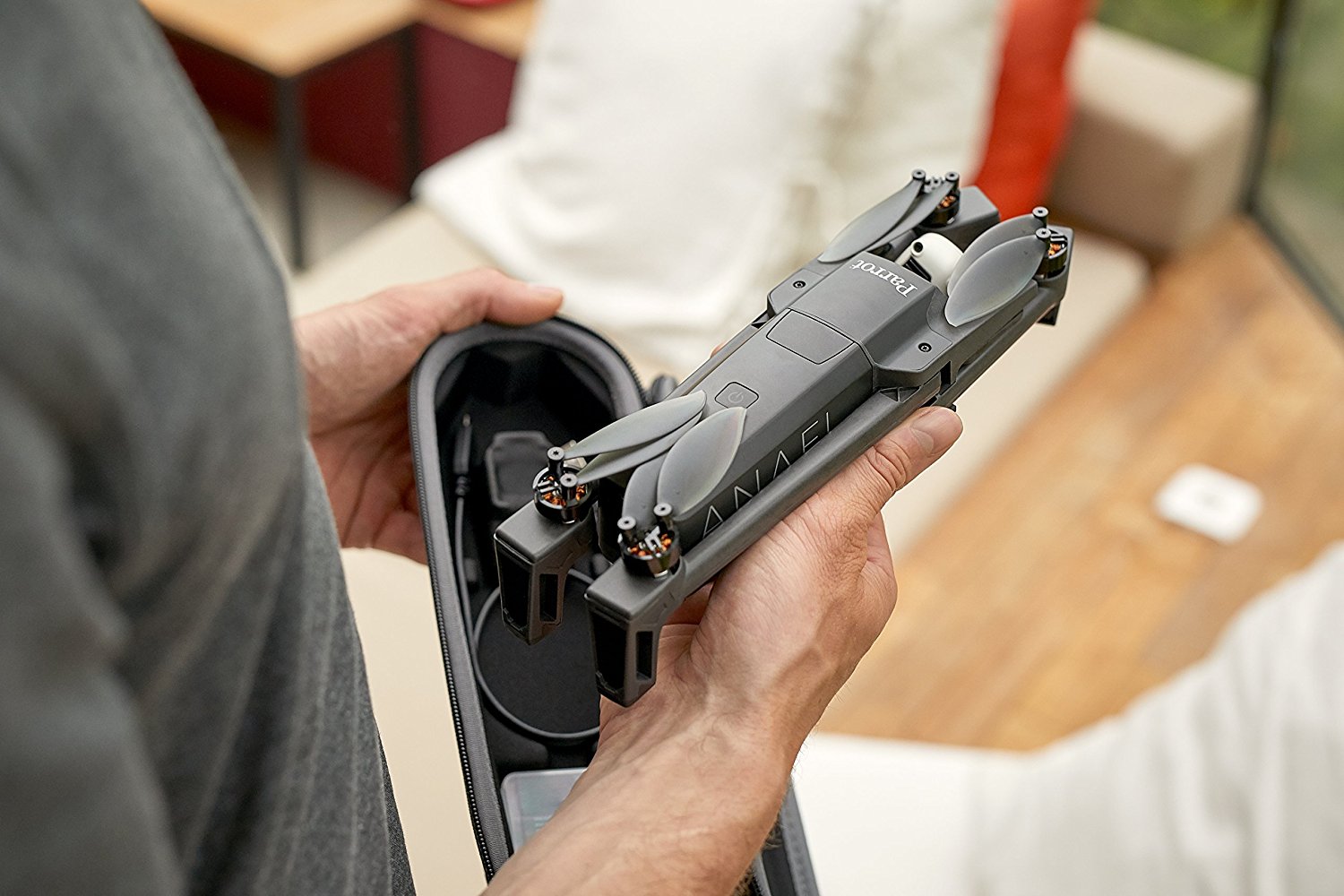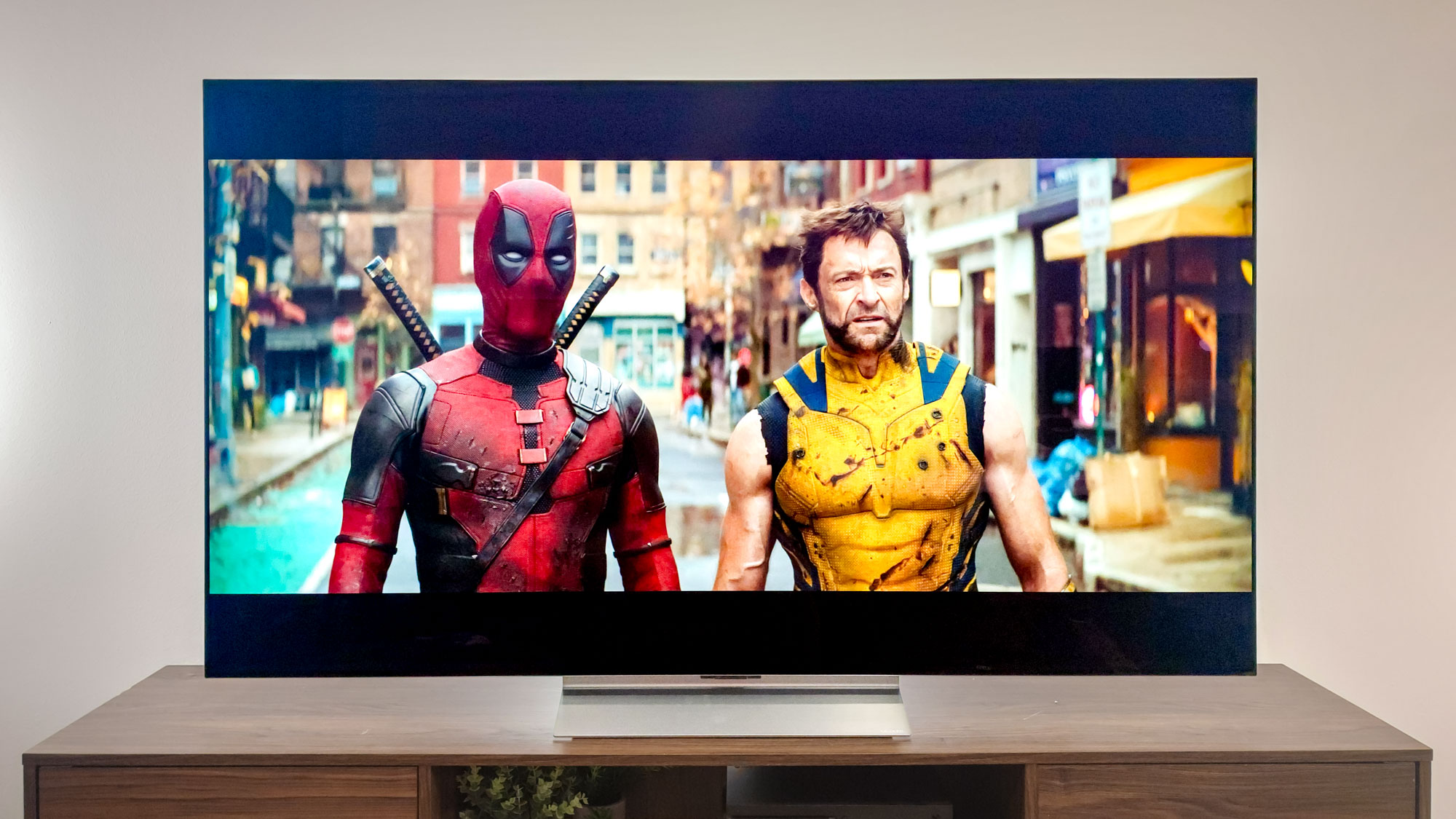Tom's Guide Verdict
Hikers, bikers and outdoor lovers will like the portability and image quality of the Parrot Anafi drone.
Pros
- +
Compact, portable package
- +
Easy to unpack and fly
- +
Excellent video
- +
Quiet
Cons
- -
No collision detection
- -
More vulnerable to wind and buffeting than larger drones
Why you can trust Tom's Guide
The Anafi is Parrot's play for the new category of drones small enough to fit into a backpack or bag for hiking but good enough to take high-quality videos of the stunning vistas you find out there. And it's a good play: The $699 Anafi is smaller, lighter and less expensive than the Mavic Air, and it takes excellent-quality 4K video, too. It isn't perfect, though: We found it got buffeted by wind a little too easily.
Updated Oct. 25:
Parrot is extending the Anafi's video capabilities with a newly available software update that adds HDR+, a Dolly Zoom capability, a hyperlapse mode that can speed up footage by 240x and a slow-motion mode that captures 120 fps footage. In November, another update will add a panorama mode to the drone's bag of tricks. A $799 Anafi Extended bundle includes the drone along with a shoulder bag, three batteries and two months of free access to Adobe Creative Cloud or Adobe Premiere Pro Creative Cloud.
Design
The Anafi is very small: When stored, the drone fits into an included case that is just 10.8 x 3.5 x 3 inches — about the size of a water bottle. The controller doesn't fit into this case, but it is also small, folding down to just 6 x 3.7 x 3 inches. With the included hard case for the drone, the combination weighs just 2 pounds, making it significantly smaller and lighter than both the Mavic Air and the GDU O2. It's an impressively portable package.
When you are ready to fly the drone, the arms of the Anafi fold out from a hinge on the front of the body, making it look something like an insect. This thin, spindly look is very different from the lumpy curves of the Mavic Air, but it is not unattractive.
The camera can rotate both downward and upward, so you can take shots from below, such as an image of you on a bridge, while the drone flies underneath it.
On the front of the long, thin body of the Anafi is the camera, a white sphere mounted in a tiny, three-axis gimbal that allows it to twist, tilt and turn. The camera can rotate both downward and upward, so you can take shots from below, such as an image of you on a bridge, while the drone flies underneath it — something the Mavic Air can't do. The gimbal feels a little fragile, but it is protected from impacts by two extensions of the case, and we found that it remained intact despite several hard landings. A lens cap fits over the camera; don't forget to remove that before flight and to replace it when you put it back in the case.
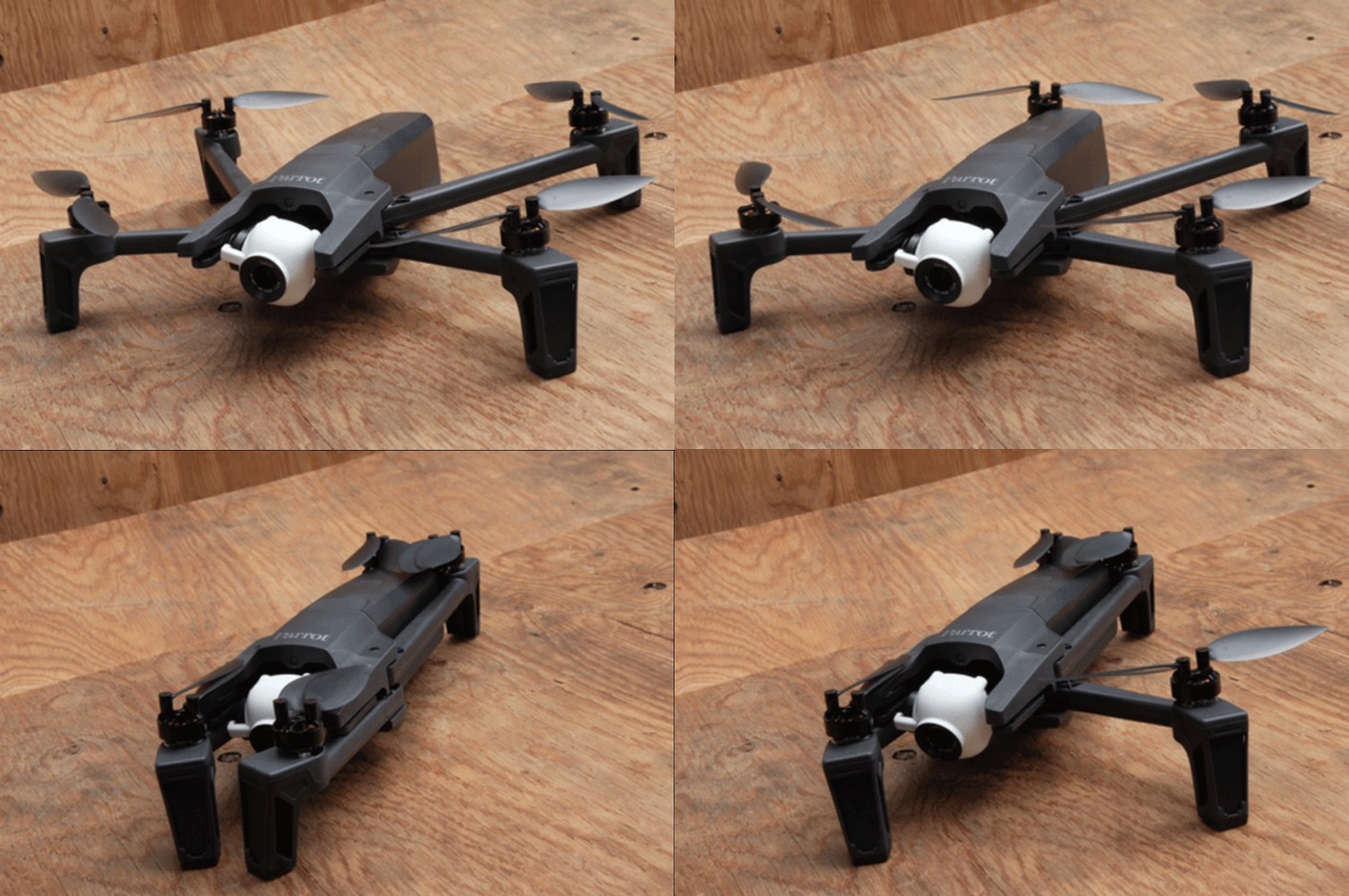
On the back of the drone body is a large, 2,700-mAh lithium-ion battery that clips firmly into place. The included 16GB microSD card that stores photos and videos fits under the battery.
Controller
The controller is compact but rather lumpy-looking, and seems somewhat incongruous next to the spindly drone itself. It is well designed, though, fitting nicely into the hand and offering plenty of controls, including the two standard control sticks and shoulder buttons and levers to control the video, gimbal angle and digital zoom features.
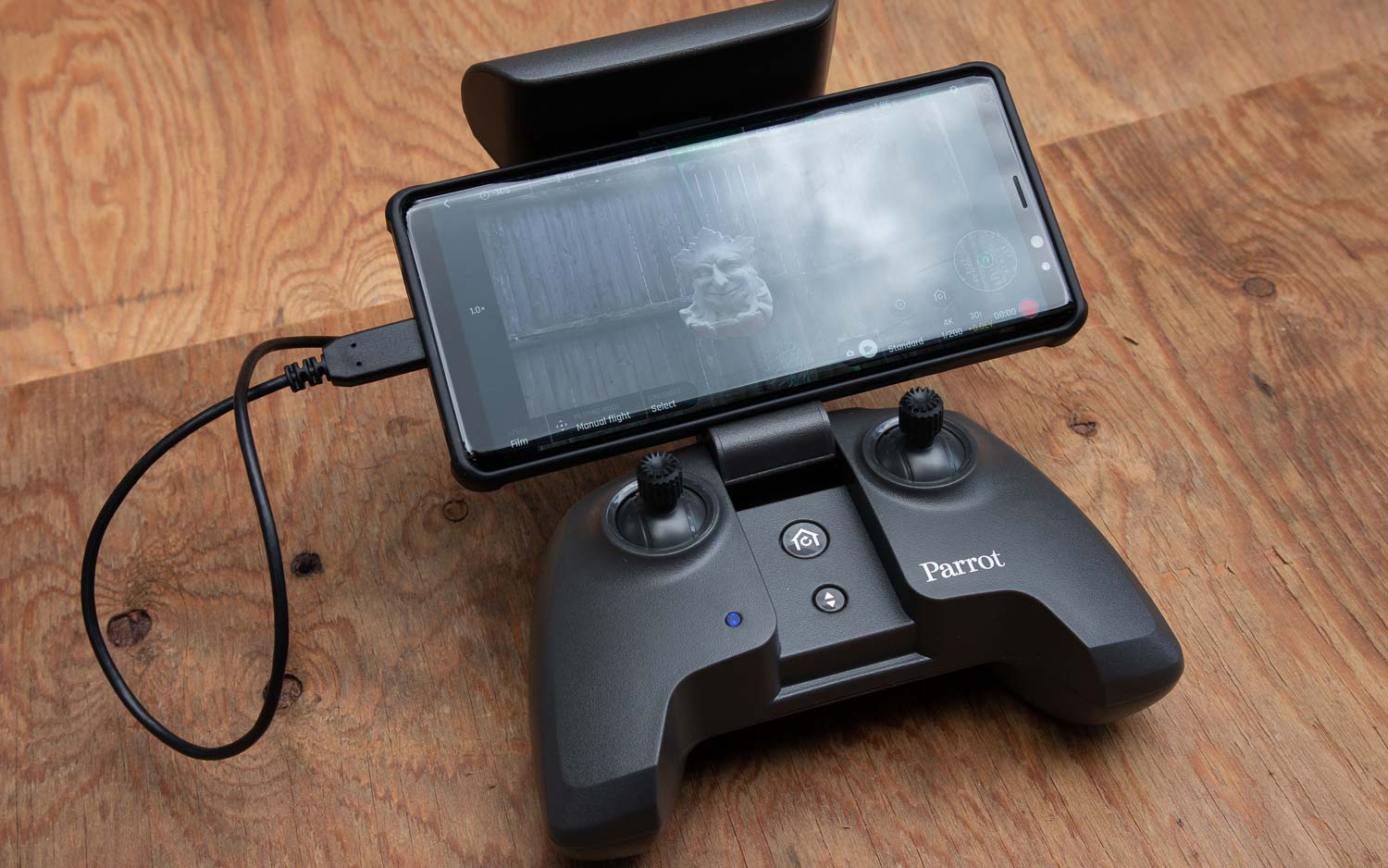
The cellphone clip flips up from the body of the controller and was able to hold a Samsung Note 8 and iPhone 7 without problems. The controller connects to the phone with a USB cable, and a USB Type-C cable is included. iPhone users will need to use the Lightning-to-USB-A cable that came with their phone. One nice touch here: The controller turns on when you lift the phone cradle and turns off when you fold it down, so you won't accidentally leave it turned on and run down the battery.
App and App Controls
The FreeFlight 6 app, available for both iOS and Android, provides a preview of the video from the drone camera, plus a selection of on-screen controls. You can use the app alone or alongside the controller. Either way, the app allows you to trigger the various shot modes and plan and trigger a flight plan on a map. It's a simple, straightforward app that works well with the flight controller. If you registered the drone with Parrot, the app also stores details of flights that can be accessed through the company's website.
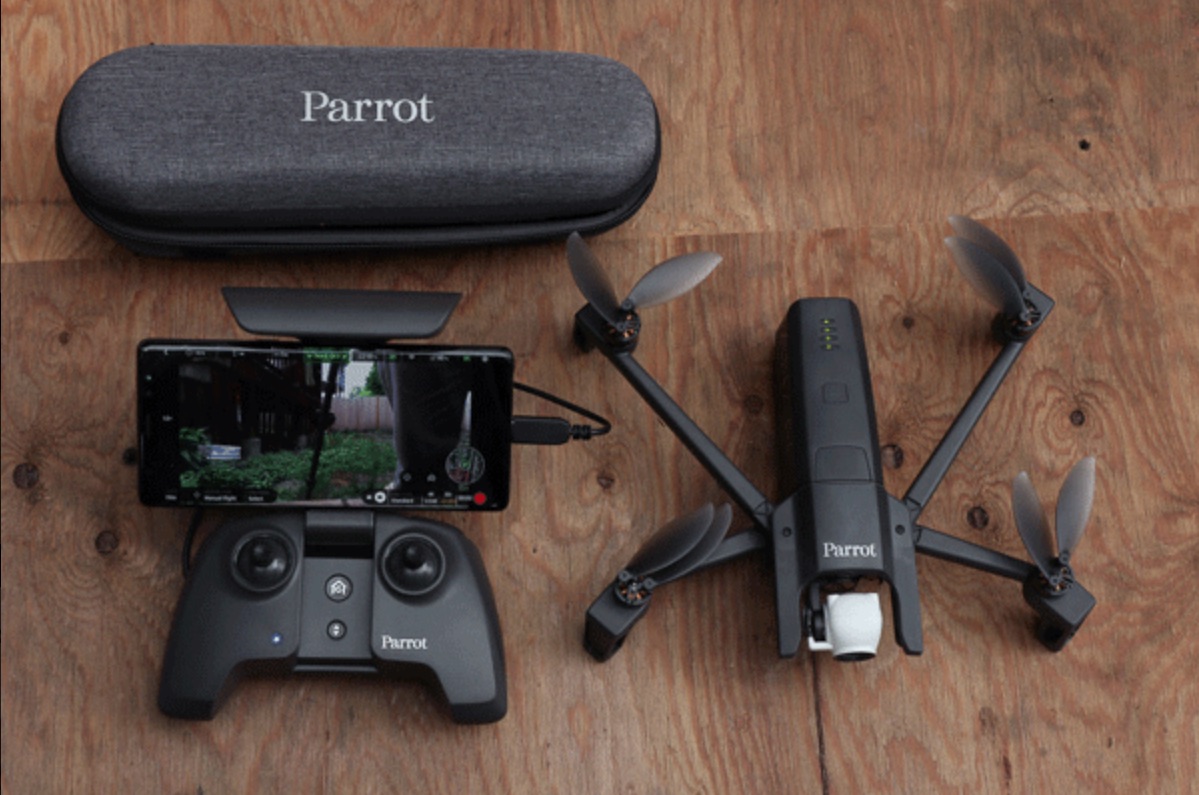
We did find a couple of glitches here, though. On more than one occasion, the beta version of the FreeFlight app we tested lost the video preview, leaving us with a blank screen while the drone was still flying. This seemed to happen while we were changing modes, such as switching from Manual to Cameraman flight modes, and the only way to restore the video was to close the app and reconnect it to the drone.
MORE: Best Drones - Quadcopters for Beginners, Kids, Racing
We also found that the Wi-Fi connection between the drone and the controller or phone was a little flaky. Several times, we got a warning about low signal strength when the drone was nearby. To be fair, this is a beta version, and Wi-Fi connections can sometimes be interrupted by other signals, but both were definite concerns.
Flight Performance
In Manual flight mode, the Anafi is a fast, maneuverable drone that can move speedily and maneuver quickly. Parrot claims a top speed of just under 35 mph, and that seems to be about right; we were able to clock the drone at a swift 27 mph flying level. That is a bit slower than the Mavic Air, which can manage up to about 40 mph, but it's plenty fast for all but drone racers.
The Anafi includes a number of useful automatic flight modes: Cameraman, SmartDronies, Touch & Fly, Follow Me and Flight Plan. In the Cameraman mode, you select a target, and the drone keeps the camera pointing toward that target, rotating the drone and tilting the camera to follow the selected object. You can move the drone with the controller, but it will keep the camera fixed on the target.
The Anafi does not include the collision detection of the Mavic Air, so it will quite happily fly into a tree or building.
SmartDronies mode offers a number of shots for the selfie crowd. These include Boomerang, in which the drone flies out and up to a defined distance and then flies back; Tornado, in which the drone spirals around you in ever-increasing circles while keeping the camera pointed at you; and Orbit and Parabola, in which the drone flies in a semicircle (or parabola), starting in front of you and ending up behind you.
In Touch & Fly mode, the drone flies to the location you select on the on-screen map, with the control sticks setting the orientation and altitude. That's a neat trick if you are trying to focus on framing your shot rather than worrying about flying the drone, but remember that the Anafi does not include the collision detection of the Mavic Air, so it will quite happily fly into a tree or building if you don't consider how it will reach the destination.
In Follow Me mode, the camera automatically tracks a selected object, tilting the camera and moving the drone to try maintaining the same distance between the subject and the drone. We found that these tracking shots worked pretty well, with the camera tracking a person in changing light conditions without issues. Again, though, they need some caution, as there is no forward collision detection.
Finally, Flight Plan allows you to create a waypoint-based flight plan, which the drone will follow upon request. That's useful if you want to film the same location in different seasons or do a time lapse of construction work, for example.
The Anafi also includes a couple of fancy video modes: Hyperlapse and Slow Motion. Hyperlapse is an accelerated time effect that captures video at a couple of frames per second and plays it back at 30 fps. The Slow Motion effect captures video at 60 fps and plays it back at 30 fps, effectively halving the speed. That's a nice feature to have but nowhere near as cool as the 240 fps that devices like the iPhone 8 can manage.
The Anafi is a small drone, and this proves to be one of the drawbacks. It is rather prone to being knocked about by gusts of wind. It does a decent job of compensating, but a sudden gust of wind or change of direction will produce a visible bump in the video.
MORE: Which DJI Drone Is Right for You?
One upside, however, is that the Anafi is much quieter than most drones. While most drones (including other small drones like the Mavic Air) are rather noisy, the Anafi is relatively quiet. It sounds like a group of angry bees that is mostly inaudible from about 20 feet away. In contrast, the Mavic Air sounds like an angry bear, even at longer distances.
Video and Photo Quality
We were impressed with the quality of the video captured by the Anafi; it had lots of detail and smooth, natural motion in both the 4K and HD modes. However the video is recorded, we found that it was very steady, with little evidence of camera shake or rolling shutter.

Unfortunately, the high dynamic range (HDR) video feature that Parrot has been advertising as one of the major selling points of the Anafi was not yet available when we tested the drone. We will update this review when this feature is released.
One unusual feature is the digital zoom: Using the shoulder switch on the controller, you can zoom in up to 2.8x when shooting 4K video and up to 3x when shooting HD video. This is a digital zoom, so there is no physical zoom lens. The quality is pretty good, though. Although we noticed a slight softness when using the zoom at its longest settings, the video still looked pretty good.
Flight Time
Parrot advertises the flight time of the Anafi at up to 25 minutes, but we found that it typically lasted for a few minutes short of this claim: about 20 to 22 minutes of flight. That's pretty typical for a drone this size and a little shorter than the Mavic Air's 27-minute flight time. Unlike with earlier Parrot drones, only a single battery is included. A spare battery costs $99.
The Anafi does not include a charger. Instead, you charge the batteries through the USB Type-C port on the back of the battery. This means that the speed of charging depends on what it is plugged into, because different types of USB port and chargers can deliver varying amounts of power. You'll get the best results from a USB-C charger designed for a modern cellphone or laptop. Using a Samsung USB-C charger, we were able to charge the battery in about 60 minutes.
Spare Parts
We found it easy to swap out spare parts for the Anafi, like the battery and the propeller blades. The latter requires an (included) hex key, so don't forget to keep that in the case. Two full sets of spare rotor blades are included. A spare battery costs $99, but the price for a spare set of propeller blades was not available when we tested the drone.
Bottom Line
The Parrot Anafi has a lot to like. It's one of the most compact full-featured drones we've ever tested, packing into a small, water-bottle-sized package that fits easily into a backpack. And when you reach the destination, it's easy to take out and fly the drone. The Anafi has a good selection of flight modes to take interesting shots, and the video it captures is pretty good, delivering clean, smooth video with plenty of detail.
But there are a couple of caveats. It's a small drone, which means it is easily buffeted by wind, and the lack of object avoidance requires more careful piloting. These factors mean we wouldn't pick the Anafi over the DJI Mini 2, but it is worth considering if you are looking for a light drone that takes excellent video.
Richard Baguley has been working as a technology writer and journalist since 1993. As well as contributing to Tom's Guide, he writes for Cnet, T3, Wired and many other publications.
-
robbie.twinkle His,was just wondering if you can help me with an issue I have with my parrot anafi, as when ever I record so video and then view it it stops and starts and glitches and jumps and was just wondering about some of my settings and if you can tell me the best settings to be on? Cheers RobbieReply -
gaftoi Maivic Air have just 21 min o flight time, not 27 as you stated in the comparsion. (that one with 27 min is the mavic pro)Reply
